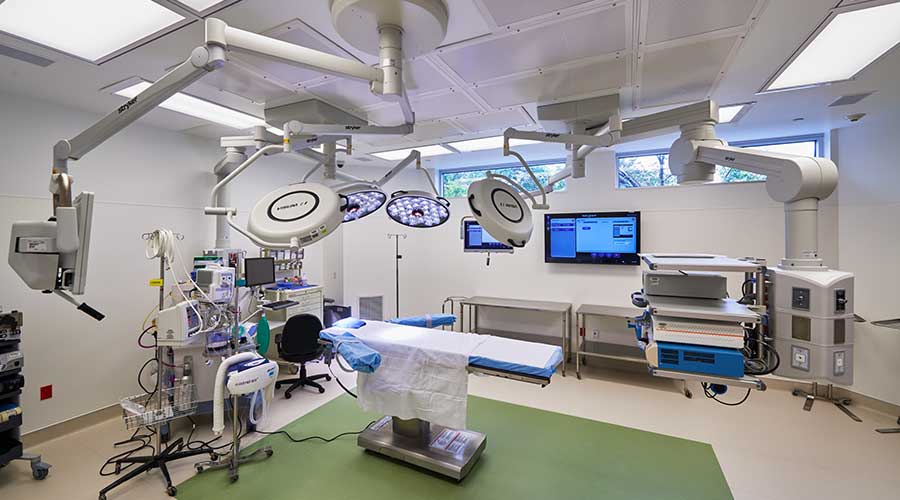Patients elect to have certain procedures performed at ambulatory surgery centers in lieu of a hospital in order to optimize their patient experience through convenience, cost savings and high-quality care. The procedure might be cataract surgery, tendon repair, a lumpectomy, an eye lift or a colonoscopy. Patients arriving at an ambulatory surgery center are usually sleepy, hungry, thirsty and a bit nervous, so the design of the space facility should immediately communicate hospitality, safety and professional competence.
Convenient location, thoughtful design and an emphasis on patient safety and comfort are hallmarks of contemporary centers. These benefits are evident in considerate wayfinding that allows a stress-free arrival experience, as well as pre- and post-operative care areas that provide efficient care. These factors and others impact patient satisfaction ratings.
Because ambulatory surgery centers tend to be quite focused, a higher emphasis can be placed on hospitality and premium patient care experience. The patient should feel welcome, secure and well cared for through the inclusion of upscale furnishings, local art, less obtrusive medical gases and equipment, private recovery rooms and individualized pain management.
A warm welcome
Thoughtful design, user-friendly amenities and hotel-like touches soothe patient and visitor anxieties and underscore operational efficiency. These features include:
- clear wayfinding that, while streamlined, feels warm and welcoming
- landscaping that feels thoughtfully planned, with seasonal touches and evergreen appeal
- convenient sidewalks and entry paths, broad areas for wheelchair accessibility, nearby parking and pull-up circles for covered drop off and pick up
- efficient, welcoming check-in and registration
- calm, uncluttered waiting areas with abundant natural light, neutral colors, natural wood, relaxing art and greenery for patients and visitors and multiple outlets for charging cell phones and computers
- upscale furnishings and accents, with furniture groupings that allow for patient and visitor privacy.
Maximizing the experience
The appeal of ambulatory surgery centers is their convenience and location, specialty focus and smaller size, attention to detail and ability to personalize the experience.
These centers also are proliferating due to rising reimbursement, expanded CMS-approved procedure lists and continued outpatient migration. Physicians in ambulatory surgery centers are increasingly and safely performing more complex and higher-acuity procedures, including total and partial joint replacements, cervical disc replacement, lumbar fusion, cardiac catheterization and retina cases. More than 90 percent of plastic surgeries now take place in private clinics and ambulatory surgery centers.
Features that demonstrate an ambulatory surgery center’s attention to detail and a personalized experience include:
- consulting and admission areas for universal protocol and private check-in experience
- universal pre- and post-operative care area design that balances flexibility, efficiency and personalized care delivery
- operating rooms spacious enough for all medical team members, equipment and gases and universal enough to host various procedures with ease of maneuverability
- technology to support advanced imaging and robotic surgery to provide high-quality care
- physician and medical team offices, work areas, conference rooms and staff lounges that address staff needs and play a vital role in recruitment and retention
- off-stage areas for delivery and stocking of supplies, medication, waste disposal, sterilization and equipment storage.
Patient satisfaction
We are seeing a 92 percent satisfaction rate with both the care and service received from ambulatory surgery centers, which allow for better quality control processes, smoother scheduling and less delay and rescheduling of procedures. Due to their smaller size, ambulatory surgery centers also allow for:
- Physician leaders and medical teams that have more input into innovative strategies for leadership, safety and quality improvement.
- Observation areas with one-on-one care for patients who need more time for recovery. Some ASCs offer private rooms for patients who have more intensive procedures and need extended recovery without needing to be in hospitals.
- Discrete yet accessible discharge areas with level, convenient wheelchair navigation and easy vehicle entry and exit for pick-up.
The profitability of ambulatory surgery centers depends on patient satisfaction and consumer choice, as well as the ability to provide fast, efficient and safe procedures at lower costs. In fact, more hospitals and academic medical centers are branching out to build or buy an ambulatory surgery center or team with specialty ambulatory surgery centers providers to focus on outpatient procedures in more affordable and convenient outpatient settings. The centers also reduce hospital overcrowding, allowing hospitals to focus on more acute surgeries.
Keeping the patient and staff experience front and center in the design of ambulatory surgery centers is about securing the bottom line as much as it is providing a feeling of elevated hospitality. But these strategies work hand in hand to create a successful ambulatory surgery centers facility that attracts plentiful patients, competent and experienced staff and stellar specialists.
Akshay Sangolli, AIA, ACHA, EDAC, LEED AP BD+C, is senior medical planner and managing principal with EYP, a Page company. Robert Doane, AIA, ACHA is a principal, project director, and health sector leader at Page.

 Building Disaster Resilience Through Collaboration
Building Disaster Resilience Through Collaboration Amae Health Expands to New York City
Amae Health Expands to New York City Hospital for Special Surgery Opens Two New Facilities in New Jersey
Hospital for Special Surgery Opens Two New Facilities in New Jersey Should We Be Testing Toilet Water in Patient Restrooms?
Should We Be Testing Toilet Water in Patient Restrooms? Healthcare Union Petitions for Increased Staff Safety at HCA Florida Hospitals
Healthcare Union Petitions for Increased Staff Safety at HCA Florida Hospitals